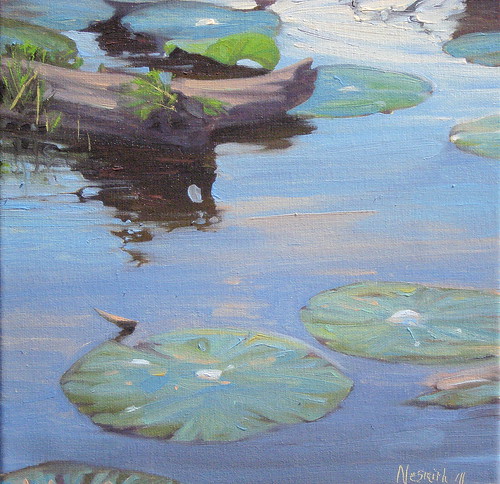 |
| "Sam Houston" Mark Nesmith Oil on Canvas 10" x 8" 2011 Click here to buy this painting. |
Daily Paintings, Art Techniques and Tips, Artist Interviews, Exhibitions, Art News and more by Mark & Elizabeth Nesmith.
Thursday, September 29, 2011
More Giants of Texas, the Sam Houston sculpture in Hunstville, TX
Tuesday, September 27, 2011
Big Tex at the State Fair of Texas
 |
| "Big Tex" Mark Nesmith Oil on Canvas 10" x 8" 2011 Click here to purchase this painting. |
Today is the first day of Fall, and that means it’s State Fair time again in Texas. The annual State Fair of Texas is held at Dallas’ historic Fair Park and has been a favorite vacation spot and tourist attraction since it started in 1886. The State Fair of Texas is the largest fair in the United States with 2,618,500 people attending in 2010. Since his debut at the 1952 fair, Big Tex has welcomed all those visitors with his booming “Howdy, folks!” He stands 52 feet tall, wears size 70 boots, a 75 gallon hat, a size 180/181 shirt, and sports a 284W/185L XXXXXL pair of Dickies jeans (I bet my wife is thinking “I’m glad I don’t have to wash his clothes!”)
Monday, September 26, 2011
Evening at Cedar Creek Lake
Click here to purchase this painting. Please visit http://www.marknesmith.com/ to view more of my artwork.
Friday, September 23, 2011
The Evolution of a Painter and the Stages of Painting Part I - Initial drawing and composition
 |
| "Twisted" (drawing stage) Mark Nesmith Charcoal on canvas 18" x 24" |
Thursday, September 22, 2011
Across the Lake at the Post Oak Preserve (en plein air)
 |
| "Across the Lake" Mark Nesmith Oil on Canvas 12" x 24" 2011 |
Near my home in Seagoville is the Post Oak Preserve, a densely wooded section of old growth oaks that is used and maintained by the Dallas ISD. The Preserve is part of the D.I.S.D. Environmental Learning Center which hosts seminars and educational field trips there. Throughout the woods are hiking trails (some paved for cycling on the weekends), along with numerous small clearings. The Preseve is populated with all manner of wildlife and makes a wonderful family hike that's close to home. Near the south end of the preserve is a small 19-acre lake.
I hiked through the woods to the lake, easel and canvas in hand and paints and brushes in my back pack. I set up in a small clearing and spent several hours painting the opposite shore. Painting outside on location demands a quick approach. The light is constantly changing. I find it helpful to mass in the main shadows and color scheme very broadly right at the beginning. To complete this size canvas in a short time I minimized details and kept the brush loosey goosey. I tend to premix several colors and variations on my palette to speed things along as well. Painting outdoors has it's charms, and it can be a very meditative and peaceful way to spend the day. I don't expect that I'll turn into an open air impressionist anytime soon, but I do find that the plein air practice really pays off when I'm back in my studio.
Sand Trap (Dreaming of the Gulf Coast shore)
Sunday, September 11, 2011
Early Morning at Caprock
The heat at Caprock Canyon in the summer was brutal, but early in the mornings it was actually quite nice. We'd wake every morning to our tent shaking in a huge breeze. With the light just starting to creep in at the horizon there's lots of wonderful contrasts in the colors, deep oranges and reds in the cliff faces and cool greens and blues in the foliage. I bought a few pre-stretched canvases in several different sizes and have been looking for the right view for this 12" x 24" canvas. I think this almost panoramic view of the canyon fits perfectly!
I've been looking at Vermeer alot lately and love his use of a shadowy foreground set against a brightly lit wall from the window. I've tried a similar idea here with the foreground using cooler and darker colors set against the warm, brightly lit hills in the distance.
Unexpected Beauty in a Roadside Ditch - NEW Water Lily Painting in Progress by Mark Nesmith
Here’s the view from my easel today. I drew up a couple of large views or water lilies from the drainage ditch past Winnie on the way to ...

-
Like many artists these days I find myself trying to make the most of my small studio space. While I lived in North Texas I was kin...
-
Being an artist isn’t cheap. As if the years of unpaid training perfecting your craft weren’t enough, the price of decent paints,...




